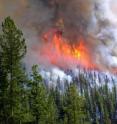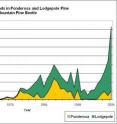Traumatized trees: Bug them enough, they get fired up
Related images
(click to enlarge)
Whether forests are dying back, or just drying out, projections for warming show the Pacific Northwest is becoming primed for more wildfires. The area burned by fire each year is expected to double – or even triple – if temperatures increase by about 3.5 degrees Fahrenheit (2 C) in our region, according to University of Washington and USDA Forest Service research. Such temperature increases could occur in as little as 40 years, according to projections from the UW's Climate Impacts Group.
"I'm not a doom-and-gloom kind of guy but this is a great concern," said Dave Peterson, a UW professor of forest resources and a biologist with the Forest Service's Pacific Northwest Research Station.
Fuels built up after a century of rushing to suppress fires have long been pointed to as the reason for growing numbers of wildfires. That's indeed a major factor, Peterson said, but starting in 1993 UW's Jim Agee, now professor emeritus of forest resources, was the first to point out that climate was probably a contributing factor.
Now it is projected that warming temperatures may not only affect wildfires but also reduce snowpack, causing higher winter runoff and the prospect of more floods washing out roads and wiping out fish habitat, Peterson said.
How to manage forests in the face of these and other challenges triggered by global warming?
The nation may look toward Washington's Olympic National Forest for ways to tackle the job. Guided by the latest information from scientists like Peterson, land managers there have moved from talking in general about climate-change effects to discussing concrete steps that may make sense. The process – an unprecedented example of collaboration in climate change adaptation – might be a blueprint for other national forests, national parks and natural resources agencies, Peterson said. The process is already occurring in national forests in California and Wyoming.
Three years ago natural resources staff officer Kathy O'Halloran of the Olympic National Forest invited Peterson and UW research scientist Jeremy Littell to start talking with managers at the park about projected climate change effects.
Ideas generated include planting more drought-tolerant species, such as western white pine and suitable varieties of Douglas fir. Another idea was to plan for higher water flows when designing log structures in creeks to enhance fish habitat, replacing culverts or planning road maintenance. Costs will have to be weighed before any steps are actually taken, O'Halloran said.
A key suggestion from scientists to planners is to recognize that cycles seen historically may not be a reliable guide to how forests will react to more fast-paced change from a warming climate.
"Climate modeling indicates that compared to the historical record, we will likely have more frequent extreme events, such as intense rain storms and heat waves," said Littell, a member of the UW's Climate Impacts Group. "That, combined with the kind of long-term climate variability we see in the historical record, puts us into new climatic territory when it comes to disturbances like wildfire and insects. We don't often plan for the combination of future extremes and the variability in the historical record."
The mountain pine beetle is an example. The tiny insect has for many decades routinely attacked and killed trees, particularly lodgepole and ponderosa pines found in mountainous areas of western United States and Canada and places such as Eastern Washington. (Outbreaks in Western Washington and Western Oregon are muted because those areas have fewer of the pine-dominated forests favored by the beetle.)
"The difference between now and our prior history is the magnitude of the impact," said Elaine Oneil, UW research associate in forest resources. "We basically have massive bark beetle outbreaks in the western U.S. and Canada over the entire extent of pines that are susceptible. We're seeing these massive mortality events of millions and millions of acres."
Such outbreaks are uncharacteristic and consistent with the idea that climate change is tipping the balance in favor of the insect over the tree, she said.
In Eastern Washington Oneil recently found a tenfold increase in the average mortality from the beetle compared to the previous 20 years. And the deaths were not because trees were growing too thickly or had outlived their natural lives, as she had expected. Instead, the mortality since 2000 seems strongly linked to climate, she said.
The result can be fires like the 2006 Tripod Complex Fire in the North Cascades of Washington. Ignited by two lightning strikes, the fire consumed 175,000 acres, or nearly 275 square miles. Oneil studied the area in the five years leading up to the fire as a massive beetle infestation took hold. Firefighters told her the areas with the greatest infestations were those that burned hottest, were the hardest to control and resulted in the most damage.
Portions of the Tripod burn area that were harvested prior to the fire are places where the forest is coming back first. This finding may aid those investigating ways to harvest or thin trees and clear surface fuels to make forest stands vigorous enough to resist both insects and fire, Peterson said. If such steps already are being taken, then making forests more climate resistant might just mean thinning a bit more heavily and removing an additional amount of fuels, he and other scientists suggest.
The effects of climate change on forests are not all negative. For some high-elevation forests, for instance, warming will mean longer growing seasons, faster growth and more tree regeneration. Still, it takes a long time for a tree to grow while it can die in a short time.
"Any change in tree growth pales in comparison to ecosystem disturbances," Peterson said. "Big fires and big insect outbreaks can kill all the trees on the landscape."
Source: University of Washington
Other sources
- Traumatized trees: Bug them enough, they get fired upfrom Biology News NetTue, 13 Apr 2010, 21:14:37 UTC
- Traumatized trees: Bug them enough, they get fired upfrom Science DailyTue, 13 Apr 2010, 18:21:20 UTC
- Traumatized Trees: Bug Them Enough, They Get Fired Upfrom Newswise - ScinewsTue, 13 Apr 2010, 1:35:18 UTC
- Traumatized trees: Bug them enough, they get fired upfrom PhysorgMon, 12 Apr 2010, 11:49:16 UTC


